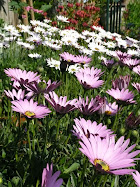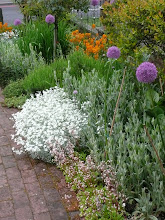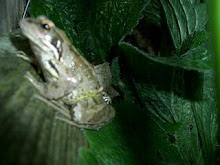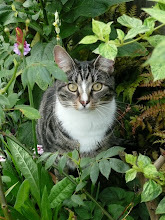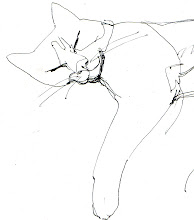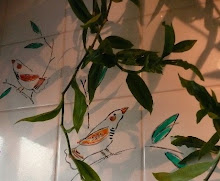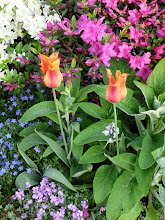L'Immoraliste is available on-line at :
http://www.ebooksgratuits.com/ebooks.phpExtract from
L'Immoraliste (1902) by Gide
Part I, Chapter IV
First the original version then, in
orange, my translation.
"Marceline, cependant, qui voyait avec joie ma santé enfin revenir, commençait depuis quelques jours à me parler des merveilleux vergers de l’oasis. Elle aimait le grand air et la marche. La liberté que lui valait ma maladie lui permettait de longues courses dont elle revenait éblouie ; jusqu’alors elle n’en parlait guère, n’osant m’inciter à l’y suivre et craignant de me voir m’attrister au récit de plaisirs dont je n’aurais pu jouir déjà. Mais, à présent que j’allais mieux, elle comptait sur leur attrait pour achever de me remettre. Le goût que je reprenais à marcher et à regarder m’y portait. Et dès le lendemain nous sortîmes ensemble.
Elle me précéda dans un chemin bizarre et tel que dans aucun pays je n’en vis jamais de pareil. Entre deux assez hauts murs de terre il circule comme indolemment ; les formes des jardins, que ces hauts murs limitent, l’inclinent à loisir ; il se courbe ou brise sa ligne ; dès l’entrée, un détour vous perd ; on ne sait plus ni d’où l’on vient, ni où l’on va. L’eau fidèle de la rivière suit le sentier, longe un des murs ; les murs sont faits avec la terre même de la route, celle de l’oasis entière, une argile rosâtre ou gris que le soleil ardent craquelle et qui durcit à la chaleur, mais qui mollit dès la première averse et forme alors un sol plastique où les pieds nus restent inscrits. – Par-dessus les murs, des palmiers. A notre approche, des tourterelles y volèrent. Marceline me regardait.
J’oubliais ma fatigue et ma gêne. Je marchais dans une sorte d’extase, d’allégresse silencieuse, d’exaltation des sens et de la chair. A ce moment, des souffles légers s’élevèrent ; toutes les palmes s’agitèrent et nous vîmes les palmiers les plus hauts s’incliner ; - puis l’air entier redevint calme, et j’entendis distinctement, derrière le mur, un chant de flûte. –Une brèche au mur ; nous entrâmes.
C’était un lieu plein d’ombre et de lumière ; tranquille, et qui semblait comme à l’abri du temps ; plein de silences et de frémissements, bruit léger de l’eau qui s’écoule, abreuve les palmiers, et d’arbre en arbre fuit, appel discret des tourterelles, chant de flûte dont un enfant jouait. Il gardait un troupeau de chèvres ; il était assis, presque nu, sur le tronc d’un palmier abattu ; il ne se troubla pas à notre approche, ne s’enfuit pas, ne cessa qu’un instant de jouer. Je m’aperçus, durant ce court silence, qu’une autre flûte au loin répondait. Nous avançâmes encore un peu, puis : « Inutile d’aller plus loin, dit Marceline ; ces vergers se ressemblent tous ; à peine, au bout de l’oasis, deviennent-ils un peu plus vastes… Elle étendit le châle à terre : -Repose toi. »
Combien de temps nous y restâmes ? je ne sais plus ; - qu’importait l’heure ? Marceline était près de moi ; je m’étendis, posais sur ses genoux ma tête. Le chant de flûte coulait encore, cessait par instants, reprenait ; le bruit de l’eau… Par instants une chèvre bêlait. Je fermai les yeux ; je sentis se poser sur mon front la main fraîche de Marceline ; je sentais le soleil ardent doucement tamisé par les palmes ; je ne pensais à rien ; qu’importait la pensée ? je sentais extraordinairement…
Et par instants, un bruit nouveau ; j’ouvrais les yeux ; c’était le vent léger dans les palmes ; il ne descendait plus jusqu’à nous n’agitait que les palmes hautes.
Le lendemain matin, dans ce même jardin je revins avec Marceline ; le soir du même jour j’y allai seul. Le chevrier qui jouait de la flûte était là. Je m’approchai de lui, lui parlai. Il se nommait Lassif, n’avait que douze ans, était beau. Il me dit le nom de ses chèvres, me dit que les canaux s’appellent séghias ; toutes ne coulent pas tous les jours, m’apprit-il ; l’eau, sagement et parcimonieusement répartie, satisfait à la soif des plantes, puis leur est aussitôt retirée. Au pied de chacun des palmiers un étroit bassin est creusé qui tient l’eau pour abreuver l’arbre ; un ingénieux système d’écluses que l’enfant, en les faisant jouer, m’expliquer, maîtrise l’eau, l’amène où la soif est trop grande."

"The clown and the flute"
Lithograph by Chagall
"For the last few days however, Marceline, who was watching with joy my health finally return, had started talking to me about the wonderful groves of the oasis. She loved the fresh air and walking. My illness had provided a certain liberation leaving her free to go for walks from which she returned elated. Up until then she had said very little about this, fearing that I might be tempted to follow her or be disheartened by her talk of pleasures that, as yet, were still beyond me. But now I was getting better she was relying on the appeal of these excursions to complete my recovery. I was being carried along by my renewed enjoyment of walking and watching. The very next day we went out together.
She led the way along a strange path the like of which I had never seen before in any country. The path ambles its way indolently between two fairly high terracotta walls that borders gently sloping gardens ; from the start it twists and turns and sometimes it seems to just stop ; a deviation will soon cause you to go astray and you no longer know where you have been or where you are going. Always close, the river skirts one of the walls, which are made with the same earth as the road and the oasis as a whole : a pinkish-grey clay that the blistering sun causes to crack, that hardens in the heat but then softens again with the first drop of rain when it becomes soft and malleable enough for naked feet to leave their imprints. – Above the walls, palm trees. Our arrival causes turtledoves to take flight. Marceline looked at me.
I forgot my fatigue and my discomfort. I was walking in a state close to ecstasy almost, of quiet joy, of exaltation of the flesh and the senses. A light breeze was picking up, stirring the palm trees and we watched as the tallest of the palms swayed backwards and forwards. Then the air became calm again and I could quite distinctly hear the sound of a flute coming from behind the wall. – A gap in the wall tempted us in.
It was a place full of light and shade ; a tranquil place where time stood still. A place full of the sound of silence, rustling, streams quietly watering the palms, and, escaping from one tree to the next, the discreet cooing of turtledoves. A child was playing a flute. He was tending a herd of goats. He was sitting down, almost naked, on the trunk of a fallen palm tree. As we approached, he didn’t get up. He didn’t run away. Only for a moment did he stop playing his flute.
During this short silence, I noticed that another flute could be heard answering in the distance. We went further into the grove, then Marceline said : “There’s no point in going any further, the groves all look the same, maybe they get a bit bigger near the end of the oasis.” She spread the shawl out on the ground. “Rest a while.”
How long did we stay there ? I don’t know – what did time matter ? Marceline was at my side ; I lay back and rested my head on her knees. The flute music flowed once more, stopping for a moment here and there before starting again ; the sound of water… From time to time a goat bleated. I closed my eyes ; I felt Marceline’s cool hand resting on my forehead ; I felt the hot sun gently filtered by the palms ; I wasn’t thinking of anything ; why bother thinking ? I felt extraordinarily…
Then, from time to time, a new sound ; I opened my eyes ; a light wind too high to disturb us, played with the tops of the palms.
The following morning, I returned to the garden with Marceline ; then later that same evening, I went back alone. The goatherd boy who had been playing the flute was there. I went up to him, spoke to him. He was called Lassif ; he was only 12 ; he was beautiful. He told me what his goats were called ; he told me that the canals are called séghias ; the water didn’t flow every day, he told me. Water was distributed wisely and parsimoniously : just enough to quench the plants’ thirst and then it was switched off. Each tree had a narrow trough hollowed at its base to hold the water it needed. And, an ingenious system of sluices, with which the child toyed as he explained its workings to me, controlled and directed the water to where the thirst was greatest."
Lithograph by Chagall










 A few days adrift in the blogosphere and I'm beginning to feel more at home with the basic functions of my blog. So, after summoning a little more courage (Me, afraid of blogs ?), it's time to start the next stage of this virtual Odyssey : the release of a French version of Colourful Language.
A few days adrift in the blogosphere and I'm beginning to feel more at home with the basic functions of my blog. So, after summoning a little more courage (Me, afraid of blogs ?), it's time to start the next stage of this virtual Odyssey : the release of a French version of Colourful Language.  When studying for my first degree in fine art I was fortunate enough to win a travel bursary, which allowed me to spend a number of weeks in France doing some preliminary research on stained glass windows. (Incidently, this is how I started learning French.)
When studying for my first degree in fine art I was fortunate enough to win a travel bursary, which allowed me to spend a number of weeks in France doing some preliminary research on stained glass windows. (Incidently, this is how I started learning French.)
 Horticulturally speaking, my current preoccupation is an orchid, or to be precise a phalaenopsis. For the profanus amongst us, the moth orchid is apparently the most popular orchid grown as a house-plant, at least in terms of the numbers sold. Up until now, I've steered clear of such exotic creatures fearing the special care they need. However, I've now acquired a specimen by way of a thank-you gift from a friend saying it with flowers.
Horticulturally speaking, my current preoccupation is an orchid, or to be precise a phalaenopsis. For the profanus amongst us, the moth orchid is apparently the most popular orchid grown as a house-plant, at least in terms of the numbers sold. Up until now, I've steered clear of such exotic creatures fearing the special care they need. However, I've now acquired a specimen by way of a thank-you gift from a friend saying it with flowers.
